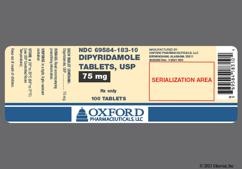
Contents
dipyridamole – oral, Persantine
Medication Uses How To Use Side Effects Precautions Drug Interactions Overdose Notes Missed Dose Storage USES: This medication is used in combination with "blood thinners" such as warfarin to prevent clots after heart valve replacements. Clots can cause strokes, heart attacks, or blocked blood vessels in the lungs (pulmonary embolisms). Dipyridamole is a platelet inhibitor It helps blood flow by preventing platelets from clumping together and keeping heart blood vessels open.OTHER This section contains uses of this drug not listed in the approved professional labeling Use this drug for a condition listed in this section only if prescribed by your health care professional.This drug may also reduce the risk of stroke in high-risk patients, such as those who have had "mini-strokes" (transient ischemia attacks), stroke, heart attack, surgery, or heart valve disease. HOW TO USE: Take this medication by mouth, usually 4 times daily or as directed by your doctor. This medication is best taken on an empty stomach, but it may be taken with meals if stomach upset occurs.Dosage is based on your medical condition and response to therapy.Use this medication regularly to get the most benefit from it. To help you remember, use it at the same times each day.Do not stop taking this medication without consulting your doctor. SIDE EFFECTS: Dizziness, stomach upset, diarrhea, vomiting, headache, and flushing may occur, particularly at first as your body adjusts to the medication. If any of these effects persist or worsen, notify your doctor or pharmacist promptly.To reduce the risk of dizziness and lightheadedness, get up slowly when rising from a sitting or lying position.Remember that your doctor has prescribed this medication because he or she has judged that the benefit to you is greater than the risk of side effects. Many people using this medication do not have serious side effects.Tell your doctor immediately if any of these rare but very serious side effects occur: weakness, fainting, stomach pain, pounding/rapid heartbeat, yellowing of eyes/skin, dark urine, unusual bleeding/bruising.Seek immediate medical attention if any of these rare but very serious side effects occur: chest pain, confusion, severe headache, slurred speech, vision changes, weakness on one side of the body.A very serious allergic reaction to this drug is rare. However, seek immediate medical attention if you notice any symptoms of a serious allergic reaction, including: rash, itching/swelling (especially of the face/tongue/throat), severe dizziness, trouble breathing.This is not a complete list of possible side effects. If you notice other effects not listed above, contact your doctor or pharmacist.In the US -Call your doctor for medical advice You may report side effects to FDA at 1-800-FDA-1088.In Canada – Call your doctor for medical advice You may report side effects to Health Canada at 1-866-234-2345.
PRECAUTIONS: Before taking dipyridamole, tell your doctor or pharmacist if you are allergic to it or if you have any other allergies. This product may contain inactive ingredients, which can cause allergic reactions or other problems. Talk to your pharmacist for more details.Before using this medication, tell your doctor or pharmacist your medical history, especially of: other heart problems (e.g., severe coronary artery disease, recent heart attack, low blood pressure), liver disease.This drug may make you dizzy. Do not drive, use machinery, or do any activity that requires alertness until you are sure you can perform such activities safely. Limit alcoholic beverages.Before having surgery, tell your doctor or dentist that you are using this medication.Older adults may be more sensitive to the side effects of this drug, especially dizziness and risk of bleeding.During pregnancy, this medication should be used only when clearly needed. Discuss the risks and benefits with your doctor.This medication passes into breast milk. Consult your doctor before breast-feeding. DRUG INTERACTIONS: Your doctor or pharmacist may already be aware of any possible drug interactions and may be monitoring you. Do not start, stop, or change the dosage of any medicine before checking with your doctor.If you are currently taking aspirin, consult your doctor promptly and ask whether to continue or stop taking it with this medication for your specific condition (e.g., stroke prevention). If you are not currently taking aspirin, consult your doctor before starting it for any medical condition.Before using this medication, tell your doctor or pharmacist of all prescription and nonprescription/herbal products you may use, especially of: adenosine, blood thinners, other medicines that affect platelets, neostigmine, pyridostigmine, riociguat, valproic acid.This document does not contain all possible interactions. Therefore, before using this product, tell your doctor or pharmacist of all the products you use. Keep a list of all your medications with you, and share the list with your doctor and pharmacist. OVERDOSE: If overdose is suspected, contact a poison control center or emergency room immediately. US residents can call their local poison control center at 1-800-222-1222. Canada residents can call a provincial poison control center. NOTES: Do not share this medication with others.Laboratory and/or medical tests may be performed periodically to monitor your progress or check for side effects. Consult your doctor for more details. MISSED DOSE: If you miss a dose, take it as soon as you remember. If it is near the time of the next dose, skip the missed dose and resume your usual dosing schedule. Do not double the dose. STORAGE: Store at room temperature at 77 degrees F (25 degrees C) away from light and moisture. Brief storage between 59-86 degrees F (15-30 degrees C) is permitted. Do not store in the bathroom. Keep all medicines away from children and pets.Do not flush medications down the toilet or pour them into a drain unless instructed to do so. Properly discard this product when it is expired or no longer needed. Consult your pharmacist or local waste disposal company for more details about how to safely discard your product.MEDICAL ALERT: Your condition can cause complications in a medical emergency. Call 1-888-633-4298 (US) or 1-800-668-1507 (Canada) to enroll in MedicAlert. Information last revised October 2013. Copyright(c) 2013 First Databank, Inc.
IMAGES
Related Disease Conditions
Raynaud’s Phenomenon
Raynaud’s phenomenon is characterized by a pale-blue-red sequence of color changes of the digits, most commonly after exposure to cold. Occurring as a result of spasms of blood vessels, the cause is unknown. Symptoms and signs of Raynaud’s phenomenon depend on the severity, frequency, and duration of the blood vessel spasm. Treatments include protection of the digits, medications, and avoiding emotional stresses, smoking, cold temperature, and tools that vibrate the hands.
Stroke
A stroke is an interruption of the blood supply to part of the brain caused by either a blood clot (ischemic) or bleeding (hemorrhagic). Symptoms may include weakness,


